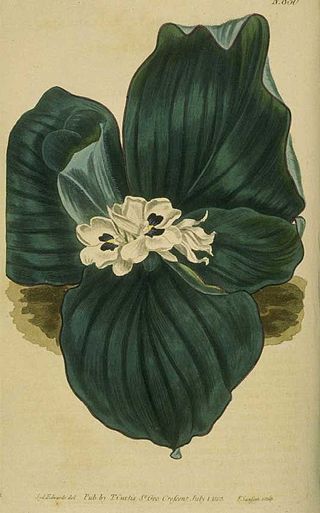
The Boltzmann constant is the proportionality factor that relates the average relative thermal energy of particles in a gas with the thermodynamic temperature of the gas. It occurs in the definitions of the kelvin and the gas constant, and in Planck's law of black-body radiation and Boltzmann's entropy formula, and is used in calculating thermal noise in resistors. The Boltzmann constant has dimensions of energy divided by temperature, the same as entropy. It is named after the Austrian scientist Ludwig Boltzmann.

Galangal is a common name for several tropical rhizomatous spices.

The alphabet for Modern English is a Latin-script alphabet consisting of 26 letters, each having an upper- and lower-case form. The word alphabet is a compound of the first two letters of the Greek alphabet, alpha and beta. The alphabet originated around the 7th century to write Old English from Latin script. Since then, letters have been added or removed to give the current letters:
Digda was a town, in what is now the Aegean Region of Turkey, during the Iron Age. The name is a Lydian word of unknown significance. This took on the Turkish form Adagide, which remained the name of the town until quite recently, when the name was officially changed to Ovakent.
Jordanian Communist Toilers Party was a communist political party in Jordan. The party was founded in 1997, through a split in the Jordanian Communist Party (JCP). The party used the name Jordanian Communist Party until it registered with the Jordanian authorities with the name Jordanian Communist Toilers Party. The party was considered more orthodox in its ideology than JCP. It reunited with the JCP in 2008.
Delkos, or Delcus, was a town of ancient Thrace. Under the name of Delcus it was a bishopric and later a titular see, now suppressed, of the Roman Catholic Church. It later called Dercos, under which name it again was a bishopric and later a titular see of the Roman Catholic Church. The Orthodox diocese remains extant.

Turkish Statistical Institute is the Turkish government agency commissioned with producing official statistics on Turkey, its population, resources, economy, society, and culture. It was founded in 1926 and headquartered in Ankara. Formerly named as the State Institute of Statistics, the institute was renamed as the Turkish Statistical Institute on November 18, 2005.
Barne Glacier is a steep glacier in Antarctica which descends from the western slopes of Mount Erebus and terminates on the west side of Ross Island, between Cape Barne and Cape Evans where it forms a steep ice cliff. It was discovered by the Discovery Expedition, 1901–04, under Robert Falcon Scott, and named by the British Antarctic Expedition, 1907–09, under Ernest Shackleton, after nearby Cape Barne, which itself is named after Michael Barne of Sotterley, Suffolk who was the second lieutenant during the Discovery Expedition.
The BC Geographical Names is a geographic name web service and database for the Canadian province of British Columbia run by the Base Mapping and Geomatic Services Branch of the Integrated Land Management Bureau. The database contains official names and spellings of towns, mountains, rivers, lakes, and other geographic places. The database often has other useful information, such as the history of geographic names, and their use in history.
Fauna Europaea is a database of the scientific names and distribution of all living multicellular European land and fresh-water animals. It serves as a standard taxonomic source for animal taxonomy within the Pan-European Species directories Infrastructure (PESI). As of June 2020, Fauna Europaea reported that their database contained 235,708 taxon names and 173,654 species names.
Endeavour Piedmont Glacier is a piedmont glacier, 6 nautical miles long and 2 nautical miles wide, between the southwest part of Mount Bird and Micou Point, Ross Island. In association with the names of expedition ships grouped on this island, it was named after HMNZS Endeavour, a tanker/supply ship which for at least 10 seasons, 1962–63 to 1971–72, transported bulk petroleum products and cargo to Scott Base and McMurdo Station on Ross Island.
Auster Glacier is a glacier about 2 miles (3 km) wide, flowing northwest into the southeast extremity of Amundsen Bay. It was sighted in October 1956 by an Australian National Antarctic Research Expeditions (ANARE) party led by P.W. Crohn, and named after the Auster aircraft used by ANARE in coastal exploration.
Kichenside Glacier is a glacier, 15 nautical miles (28 km) long and 3 to 5 nautical miles wide, flowing northeast into the southern part of the Hannan Ice Shelf on the coast of Enderby Land, Antarctica. It was charted from air photos taken from an Australian National Antarctic Research Expeditions aircraft in 1956, and was named by the Antarctic Names Committee of Australia for Squadron Leader James C. Kichenside, RAAF, officer commanding the Antarctic Flight at Mawson Station in 1960.
Assender Glacier is a glacier flowing west into Spooner Bay in Enderby Land, Antarctica. It was plotted from air photos taken from Australian National Antarctic Research Expeditions aircraft in 1956, and named by the Antarctic Names Committee of Australia for Pilot Officer Ken J. Assender, RAAF, pilot at Mawson Station in 1959.

Radenska is a Slovenia-based worldwide known brand of mineral water, trademark of Radenska d.o.o. company. It is one of the oldest Slovenian brands.
Eumeneia or Eumenia was a town of ancient Phrygia, situated on the river Glaucus, on the road from Dorylaeum to Apameia. It is said to have received its name from Attalus II, who named the town after his brother and predecessor, Eumenes II. As of the 19th century, ruins and curious sculptures still marked the place as the site of an ancient town. On some coins found there we read Εὐμενέων Ἀχαίων, which seems to allude to the destruction of Corinth, at which troops of Attalus were present. The district of the town bore the name Eumenetica Regio, mentioned by Pliny the Elder. It was inhabited during Hellenistic, Roman, and Byzantine times; for a time it also bore the name Fulvia.
Apfel Glacier is a glacier about 5 nautical miles (10 km) wide and 20 nautical miles (40 km) long, flowing west-northwest along the south flank of the Bunger Hills and terminating in Edisto Ice Tongue. It was mapped from air photos taken by U.S. Navy Operation Highjump, 1946–47, and named by the Advisory Committee on Antarctic Names for Earl T. Apfel, professor of geology at Syracuse University, who served as geologist with the U.S. Navy Operation Windmill parties, 1947–48, which established astronomical control stations along Queen Mary, Knox and Budd Coasts.
MacNamara Glacier is a glacier in the Patuxent Range of the Pensacola Mountains in Antarctica, draining northeastward between the Thomas Hills and Anderson Hills to Foundation Ice Stream. It was mapped by the United States Geological Survey from surveys and U.S. Navy air photos, 1956–66, and was named by the Advisory Committee on Antarctic Names for Edlen E. MacNamara, a United States Antarctic Research Program exchange scientist at Molodezhnaya Station, winter 1967.
Plants of the World Online (POWO) is an online database published by the Royal Botanic Gardens, Kew. It was launched in March 2017 with the ultimate aim being "to enable users to access information on all the world's known seed-bearing plants by 2020". The initial focus was on tropical African Floras, particularly Flora Zambesiaca, Flora of West Tropical Africa and Flora of Tropical East Africa.
Metropolis was an ancient town in the southern part of Phrygia, belonging to the conventus of Apamea. That this town is different from the more northerly town of the same name in northern Phrygia, is quite evident, even without knowing that Stephanus of Byzantium mentions two towns named Metropolis in Phrygia, and that Hierocles. and the Notitiae speak of a town of this name in two different provinces of Phrygia. In Roman times, it was assigned to the province of Pisidia, where it became a bishopric. No longer a residential see, it remains, under the name Metropolis in Pisidia, a titular see of the Roman Catholic Church.




